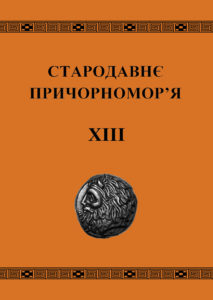Стародавнє Причорномор’я. Випуск XIII / Голов. ред. І. В. Нємченко. – Одеса: Одеський національний університет імені І. І. Мечникова, 2021. – 442 с.
Нємченко І.В. 100-річчя Петра Йосиповича Каришковського (1921–1988)
Демин О.Б. Путь к античной нумизматике: формирование научных интересов П. О. Карышковского
Избаш-Гоцкан Т.А., Колесниченко Е.А. К вопросу о творческом наследии Петра Осиповича Карышковского
Агульников С. Комрат-XV – новое поселение античного периода в Буджакской степи.
Ardeţ A. A new reinterpretation of a type of North Pontic amphora discovered in Dacia at Drobeta.
Белецкая О. «Czarnigrod, ubi Dniestr fluvius dictus mare intrat …» (Черный город в XIV-XVI вв.)
Булатович С. А. Колхидки в собрании Одесского археологического музея
Бурдо Н. Б. 100-річний ювілей Марії Ґімбутас
Відейко М.Ю. «Усатівські війни»: пошуки супротивника
Головко О. Битва на р. Мозгава 13 вересня 1195 р. (причини, хід і наслідки конфлікту)
Гребенников В. Б. История исследований поселений бронзового века в Нижнем Побужье
Гребцова И. С. Картины голландского караваджиста Геррита ван Хонтхорста в европейских музеях
Демчук С. А. Еразм Роттердамський, «Світське застілля» та «реформа» бенкету
Димидюк Д. А. Наконечник важкого списа з території Двіну (Х–ХІІІ ст.)
Добролюбский А.О. , Смирнов И.А. «…Что тут хан имел в виду…»?
Зелінський А. Л. Антиох II и Родос во время II Сирийской войны: возможная цель военного альянса
Иванова С. В., Красножон А. В. Археологические поиски Хаджибейского замка
Кахидзе Э. Исторические данные о крепости Апсар
Кіосак Д. До абсолютної хронології найсхідніших поселень культури лінійно-стрічкової кераміки
Козленко Р. О. Монети ранньої Римської імперії в Ольвії: динаміка надходження
Колесниченко А. М. Нові черняхівські поселення на Кривоозерщині
Croitoru C. The Venus pudica Phenomenon (I). ITS beginnings
Ліхтей І.М. Протидія чеського короля Вацлава І монголо-татарській загрозі у 1241 році
Лобанова М. А. Реконструкція плану трипільського поселення Сабатинівка І за архівними матеріалами
Луговий О.М. Ще раз про Маврокастрон та Аспрокастрон. «Чорне» ім’я «Білої» фортеці?
Масюта Д.А., Пиструил И.В. Археологические разведки вблизи парка «Дюковский сад» в г. Одессе
Николаев Н.И. Ольвийские «борисфены»: П.О. Карышковский или В.А. Анохин?
Одрін О.В. Грецькі eschatia і аграрна історія полісів Північної Надчорноморщини
Охотников С.Б. Научные археологические общества в Одессе
Охріменко О. С. Молитва ангелу-охоронцю з французького Часослова ХIV ст. з колекції НБУВ
Паламарчук С.В. Об античных предшественниках городов левобережья Нижнего Дуная в Одесской области
Пересунчак О. С. Березівка ІІІ – пам’ятка білозерської культури на Середньому Побужжі
Пилипчук Я. В. Социальная терминология и властные структуры в истории Кавказской Албании
Попова Т.Н. Бициллиеведение: имена и смыслы
Прохненко І. А., Жиленко М. А., Калініченко В. А. Фальшивомонетна справа на Хустському замку
Редина Е., Савельева Е. К вопросу о терракотовых «погремушках» Боспора
Руссев Н. Д. Денежное обращение и монетные эмиссии правобережного Поднестровья в эпоху Золотой Орды
Ручинська О.А. Благодіяння ольвійської еліти у перші сторіччя н.е.
Савельев О. К. Фрагмент римского фигурного светильника из Тиры
Федорук А. В. Битва при Мурсе (351 г.) в освещении риторических произведений цезаря Юлиана
IN MEMORIAM. Кушнір В.Г., Сминтина О.В. Олександр Миколайович Дзиговський (15.02.1953 – 29.12.2020)



